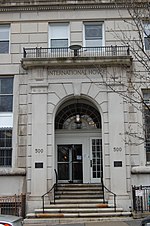Prentis Hall
Columbia University campusHarlemIndustrial buildings and structures in ManhattanNew York (state) building and structure stubsNew York (state) university stubs

Prentis Hall is a historic building located on the Manhattanville campus of Columbia University at 632 West 125th Street. It houses the university's department of music and the Computer Music Center, as well as facilities for the School of the Arts. It is one of three historic buildings that survived in the university's Manhattanville plan, the others being the Studebaker Building and the Nash Building.
Excerpt from the Wikipedia article Prentis Hall (License: CC BY-SA 3.0, Authors, Images).Prentis Hall
West 126th Street, New York Manhattan
Geographical coordinates (GPS) Address Nearby Places Show on map
Geographical coordinates (GPS)
| Latitude | Longitude |
|---|---|
| N 40.8165 ° | E -73.9595 ° |
Address
Columbia University, Manhattanville Campus
West 126th Street
10027 New York, Manhattan
New York, United States
Open on Google Maps










